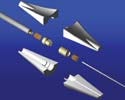April 6, 2004
OriginallyPublished MPMN April 2004PROFILE
Built-In Connectors Save OEMs Design Time and Cost
A staple of consumer electronic products, molded-in connectors can also benefit medical devices
|
Built-in connectors from Omnetics Connector Corp. are designed to be molded directly into medical devices such as probe assemblies and catheters. |
Mobile phones, laptop computers, and digital cameras all contain electrical connectors molded into their enclosures.
Cables are hidden inside hinges and shells and behind displays to save space, weight, and money. Forsimilar reasons, electromedical instruments are increasingly adopting this technology.
The medical industry has seen a rapid rise in the use of electronics and sensors in catheters, defibrillators, monitors, and related products. New medical chip sets are capable of handling multiple data channels; theyalso process a wide range of display information, machine orders, and pump signals. To perform these tasks, many probes, sensors, and detectors integrate the requisite wiring, cables, and connectors.
"Our built-in connectors are designed to be molded directly into medical equipment," says Robert Stanton, director of technology at Omnetics Connector Corp. (Minneapolis, MN; www.omnetics.com). The connector insulators are first assembled with pins or sockets that have been prewired or have solder lugs on the back, he explains. Mechanical assembly drawings are used to size and specify the internal fit of the overmolded housings, handles, or probes that contain the connectors. The final probe or assembly is then molded over the component. "Based on the application, customerscan choose among a number of materials--from soft silicones to the hard glossy white plastics used in
tool handles--for the outer shell," adds Stanton.
A perfusion monitor with built-in connectors in the probe assembly is one example of how this technology can optimize medical equipment. The product couples an instrument designed to withstand rigorous cleaning and sterilization with a disposable part in the probe assembly.
"The insert portion of the miniature connector is overmolded onto a part that serves as a connector and handle for the small electronic probe," says Stanton. "In this case, the end of the probe contains a thermistor that changes electrically with variations of temperature." A surgeon inserts the probe into a patient's body to monitor blood and tissue temperature during a procedure. After the procedure, the patient end of the cable assembly can be discarded and the instrument cable disinfected for reuse.
Miniature circular connectors enable the design of quick-change probes and sensors for a number of medical diagnostics applications. The standard building sets of circular insulators have alignment keys in the insulators to provide error-free mating and easy attachment, explains Stanton. Socket shrouds protect the pin and socket elements. "We begin the integration process using these standard sets," says Stanton. The internal fit of the overmolded housing, handle, or probe is sized, and the outer portion of the equipment is then configured to suit the application.
The connectors are made with military-grade materials that meet the quality and reliability standardsrequired by medical device manufacturers. The pins and sockets are fabricated from annealed beryllium- copper and are spring-tensioncontrolled before being plated with nickel and gold. Circular insulators are molded from a glass-filled liquid-crystal polymer that exceeds most temperature and chemical requirements specified by the industry. The Teflon-insulated wires are preassembled or supplied with solder cups to allow attachment during equipment configuration.
Omnetics engineers have extensive experience in the use of USP Class VI materials, adds Stanton, and they routinely offer assistance to customers seeking regulatory approval in the United States and Europe. Indeed, many of the assemblies have already passed reliability and quality tests needed to achieve FDA approval. "Specific-application testing and certification are all that remain for the OEM to ensure that the final design meets the new application's regulatory needs," says Stanton.
Medical applications in which built-in connectors are currently used include laser-tool handles, probes, sensors, electronic catheters, extended optical inspection devices, and even robotic instruments. Bone-conduction hearing aids are good candidates, because they require tiny, lightweight, easy-to-mount parts. Surgical tools and ultrasound equipment use integrated connectors to enable rapid tool and head replacement.
Copyright ©2004 Medical Product Manufacturing News
You May Also Like



